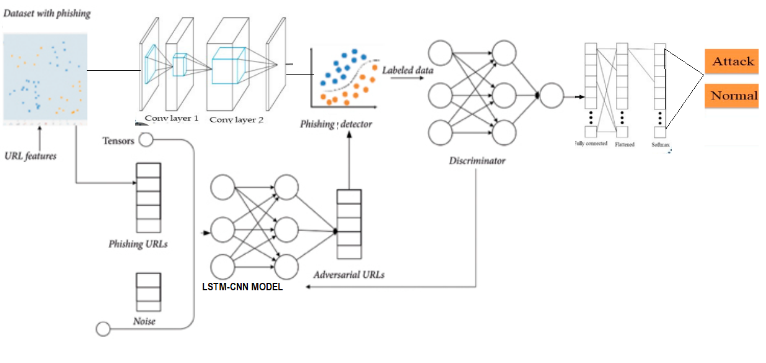Deep Learning Multi-Agent Model for Phishing Cyber-attack Detection
Main Article Content
Abstract
Phishing attacks have become one of the most prominent cyber threats in recent times, which poses a significant risk to the security of organizations and individuals. Therefore, detecting such Cyber attacks has become crucial to ensure a secure digital environment. In this regard, deep learning techniques have shown promising results for the detection of phishing attacks due to their ability to learn and extract features from raw data. In this study, we propose a deep learning-based approach to detecting phishing attacks by using a combination of convolutional neural networks (CNN) and long short-term memory (LSTM) networks. Our proposed model extracts features from the URL and email content to detect phishing attempts. We evaluate the proposed approach on a real-world dataset and achieve an accuracy of over 95%. The results indicate that the proposed approach can effectively detect phishing attacks and can be utilized in real-world applications to ensure a secure digital environment.
Article Details
References
. J. Guo, Y. Cui, and Y. Zhou, "A hybrid deep learning model for phishing website detection," IEEE Access, vol. 6, pp. 42998-43006, 2018.
. S. Khan and B. Islam, "A novel approach for detecting phishing websites using LSTM-based deep neural network," Computers & Security, vol. 82, pp. 335-348, 2019.
. S. S. Das and S. P. Mohanty, "PhishGuru: A deep learning-based intelligent phishing detection system," Future Generation Computer Systems, vol. 91, pp. 732-744, 2019.
. Kaushik P., Enhanced Cloud Car Parking System Using ML and Advanced Neural Network; International Journal of Research in Science and Technology, Jan-Mar 2023, Vol 13, Issue 1, 73-86, DOI: http://doi.org/10.37648/ijrst.v13i01.009
. J. Jiang, J. Xu, H. Wang, and X. Ma, "Combining convolutional and recurrent neural networks for detecting phishing websites," Journal of Computer Science and Technology, vol. 34, no. 3, pp. 560-570, 2019.
. 5.A. Y. Osman, A. I. Awad, and A. M. Hamdy, "PhishNet: A deep learning-based approach for phishing detection and classification," Journal of Ambient Intelligence and Humanized Computing, vol. 11, no. 4, pp. 1267-1280, 2020.
. Rathore, R. (2022). A Review on Study of application of queueing models in Hospital sector. International Journal for Global Academic & Scientific Research, 1(2), 1–6. https://doi.org/10.55938/ijgasr.v1i2.11
. Kaushik, P (2022). Role and Application of Artificial Intelligence in Business Analytics: A Critical Evaluation. International Journal for Global Academic & Scientific Research, 1(3), 01–11. https://doi.org/10.55938/ijgasr.v1i3.15
. Kaushik P., Deep Learning and Machine Learning to Diagnose Melanoma; International Journal of Research in Science and Technology, Jan-Mar 2023, Vol 13, Issue 1, 58-72, DOI: http://doi.org/10.37648/ijrst.v13i01.008
. Rathore, R. (2022). A Study on Application of Stochastic Queuing Models for Control of Congestion and Crowding. International Journal for Global Academic & Scientific Research, 1(1). https://doi.org/10.55938/ijgasr.v1i1.6
. Kaushik, P. (2023). Artificial Intelligence Accelerated Transformation in The Healthcare Industry. Amity Journal of Professional Practices, 3(01). https://doi.org/10.55054/ajpp.v3i01.630
. Kaushik, P. (2023). Congestion Articulation Control Using Machine Learning Technique. Amity Journal of Professional Practices, 3(01). https://doi.org/10.55054/ajpp.v3i01.631
. Sharma, V. (2022). A Study on Data Scaling Methods for Machine Learning. International Journal for Global Academic & Scientific Research, 1(1), 23–33. https://doi.org/10.55938/ijgasr.v1i1.4
. Rathore, R. (2023). A Study Of Bed Occupancy Management In The Healthcare System Using The M/M/C Queue And Probability. International Journal for Global Academic & Scientific Research, 2(1), 01–09. https://doi.org/10.55938/ijgasr.v2i1.36.

